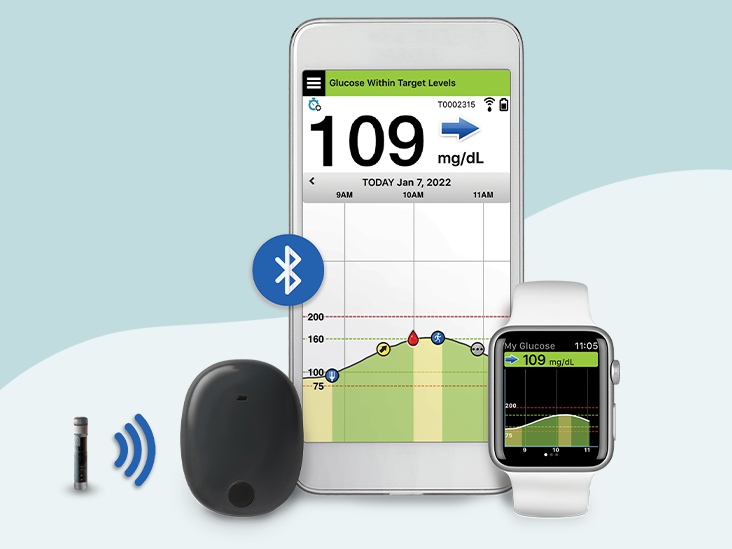Traditional CGMs consist of a sensor worn externally on the abdomen or arm that takes glucose readings via a tiny cannula (built-in plastic tube) that pierces the skin. The sensor is typically worn for 7 to 10 days before you need to replace it, using an autoinserter device that comes with the system.

Eversense is entirely different. It’s a first-of-its-kind sensor that is implanted under the skin for a number of months, rather than days. To get readings, you do have to wear a transmitter on top of your skin over the sensor insertion site that stays in place with a silicon-based adhesive backing. But this is something you just slap on like a Band-Aid.
Note that the transmitter is a black square, so not particularly discreet. But the upside is that you can take it off whenever you wish, without wasting anything but a single adhesive backing.
This is the company’s third version of the Eversense implantable CGM. The first was the 90-day Eversense sensor, followed by the Eversense XL that lasted 180 days but has only been available outside the United States.
Now, the Eversense E3 offers a new level of convenience:
Aside from that, the basics of the Eversense system remain pretty much the same:
Tiny sensor. The sensor is a miniature transparent rod, thinner than a Tylenol tab, that’s implanted several inches under the skin. It’s FDA-approved to go in the upper arm, though some users internationally have reported having had it inserted on their abdomen. Once inserted, the sensor has a one-time warmup period of 24 hours where no data is displayed as it gets used to the person’s body.
Doctor’s office implantation. Insertion takes place in a doctor’s office in a roughly 10-minute procedure. All that’s needed is lidocaine and a specially designed tool to insert the sensor in a pocket of skin about twice as deep as a regular CGM cannula would go.
Adults only. This is not FDA labeled for anyone under 18 years old, though Senseonics chief medical officer Dr. Fran Kaufman says the company plans to pursue that clinical trial research ASAP now that the product is approved.

Black transmitter, needs charging. As noted, the rub for some folks may be the need to wear the transmitter on the skin, attached with an adhesive directly above the inserted sensor. The transmitter is a flat black disc, a little thinner than two stacked quarters. It’s smaller than an Omnipod insulin patch pump, but bigger than the Abbott FreeStyle Libre flash glucose sensor. It sends data to the companion smartphone app every 5 minutes.
The transmitter can be removed and reattached as often as desired, for a shower or sports, but naturally no data will be transmitted while it is off. It also needs to be recharged daily for 10 to 15 minutes using a cable provided. The transmitter has a hard shutoff at 180 days based on an internal clock, so in case you’re wondering, there is no possibility to restart an expired sensor.
Light-sensing tech. The device uses novel, proprietary light-based technology to measure glucose levels. The sensor is coated with a fluorescent chemical that, when exposed to blood sugar, produces a small amount of light that is measured by the sensor.
On-body vibration. One very cool feature is that the Eversense transmitter actually vibrates on the body to alert users to highs and lows, varying the amount of vibrations depending on where glucose levels are. This means you can disable all the annoying audio alerts if you so choose.
No receiver, smartphone only. What’s also novel is that this system does not include a separate receiver as an option to smartphone connection. That means to use it, you must have a compatible Android or iOS device (iPhone, Android, iTouch, iPod, or tablet). While the straight-to-phone connectivity is an exciting trend, it’s also a potential roadblock for some people.
Mobile app. The app displays a colored bar at the top that shows clearly whether your glucose levels stand in Red, Yellow or Green regarding target range. The easy-to-use menu includes an Alert History, where you can see records of every High Alert, Low Alert, Transmitter Disconnected or Calibrate Now alert received, with exact day and time. This is super useful for going back over your day or week to retrace your steps. You can also see a Reports section with a Weekly Modal Summary, a Glucose Pie Chart mapping out your past days and months’ of data, as well as a Glucose Stats Report displaying your average, highest and lowest readings, and standard deviation broken down by time of day.
Predictive alerts. Along with the traditional Low, High, and Rate of Change alerts, the Eversense can predict when you’re going to go Low or High as much as 10 to 30 minutes in advance, providing those predictive alerts either via the on-body vibration feature or via the mobile app, which can give an audible alert or even flash a light to catch attention.
Data sharing. To email any of these reports to a recipient of your choice, you just click on the Share icon in the upper right of the screen. If you click into the Share My Data area, you can also send email invitations to your doctors or loved ones to be able to view your continuous stream of data, including alerts and events logged.
This content was originally published here.

